 Image search results - "omi-hachiman" Image search results - "omi-hachiman" |

At 271 meters high, Mt.Hachiman-yama was the site of Hachiman Castle built by Toyotomi Hidetsugu in 1585. Now home to Zuiryuji temple of the Nichiren Sect, some of the castle's stone walls still remain. MAP
|
|

The 31st temple on the Saigoku (Western Japan) Pilgrimage circuit, Chomeiji (Long Life Temple) worships the Kannon goddess dedicated to long life and good health. It belongs to the Tendai Buddhist sect. This sign points the way.Accessible by bus from Omi-Hachiman Station.
|
|

Musa-juku was the sixty-sixth of the sixty-nine stations or shukuba post towns on the Nakasendo Road. It is the seventh Nakasendo station in Shiga (following Echigawa-juku in Aisho). MAPMusa was one of ten Nakasendo stations in Shiga. There is very little left. Near Ohmi Railways Musa Station, a short ride from Omi-Hachiman.
|
|

Hachiman-yama ropeway stationA short walk from Hachiman-bori canal.
|
|

Entrance to Chomeiji Temple. MAP
|
|

Site of Musa-juku's Honjin, the town's exclusive lodging for VIPs to stopover or rest. Only the gate remains.
|
|

Shinmachi-dori road with traditional Omi merchant homes. This area is also a National Important Traditional Townscape Preservation District (重要伝統的建造物群保存地区). 近江商人の新町通り MAP
|
|

Okishima (Okinoshima) is Lake Biwa's largest island inhabited by over 400 residents, mainly into fishing. Short boat ride away from Omi-Hachiman's Horikiri port. MAP
|
|

In Omi-Hachiman, Shinmachi-dori looking toward Hachimanyama. This area is also a National Important Traditional Townscape Preservation District (重要伝統的建造物群保存地区).
|
|

Misty Horikiri Port in Omi-Hachiman. Boats leave here for Okishima island, Lake Biwa's largest island.
|
|
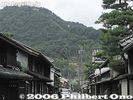
Shinmachi-dori looking toward Hachimanyama
|
|

Fishing boats at Horikiri Port
|
|

Boat for Okinoshima at Horikiri Port
|
|
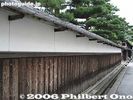
Wall
|
|

Leaving Horikiri Port
|
|
|
|
|

Local Artifacts Museum (Kyodo Shiryokan) 郷土資料館。近江商人・西村太郎右衛門の宅地跡にある資料館
|
|
|
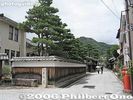
Shinmachi-dori next to Local Artifacts Museum
|
|

Misty Omi-Hachiman coast
|
|
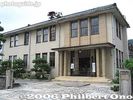
Local Artifacts Museum (Kyodo Shiryokan). Former residence of Omi merchant Nishimura Tarouemon. 郷土資料館
|
|
|
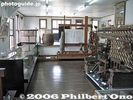
Inside Local Artifacts Museum (Kyodo Shiryokan)
|
|
|
|

Hachiman-yama ropeway takes only 4 min. to go up
|
|
|

Musa's Honjin
|
|
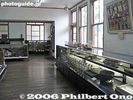
Inside Local Artifacts Museum (Kyodo Shiryokan)
|
|

Okinoshima in sight
|
|
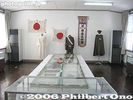
Connected to the Local Artifacts Museum is the History and Folklore Museum (Rekishi Minzoku Shiryokan) 歴史民族資料館
|
|

Misty Okinoshima
|
|

Soldier's uniform, History and Folklore Museum
|
|

Entering Okinoshima Port. Okishima is the largest island in Lake Biwa. MAP
|
|

History and Folklore Museum
|
|
|

Soldier's send-off flag, History and Folklore Museum
|
|

Side of boat
|
|
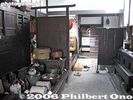
Omi merchant daily implements, History and Folklore Museum
|
|

Okinoshima Port
|
|
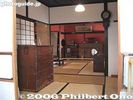
Omi merchant house, History and Folklore Museum
|
|

Okinoshima Port and boat schedule
|
|
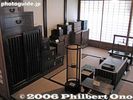
Omi merchant furniture, History and Folklore Museum
|
|

Okishima Port
|
|

Omi merchant furniture, History and Folklore Museum 近江商人の帳場風景
|
|

Sea wall
|
|
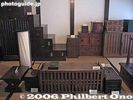
Omi merchant desk, History and Folklore Museum 近江商人の帳場風景
|
|
|

808 steps to Chomeiji. Chomeiji (Long Life Temple) worships the Kannon goddess dedicated to long life and good health. It belongs to the Tendai Buddhist sect.
|
|
|

Honjin sign
|
|
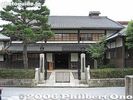
Former Ban family Omi merchant home which also served as a girls school and public library until 1997. Omi-Hachiman, Shiga. 旧伴家住宅Opened to the public in 2004 as a museum. 伴庄右衛門は江戸時代初期から活躍した八幡商人の一人で、屋号を扇屋といい、主に畳表・蚊帳を商い豪商となった。
|
|
|
|
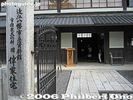
Entrance to former Ban family residence. Completed in 1840. 旧伴家住宅伴庄右衛門は江戸時代初期から活躍した八幡商人の一人で、屋号を扇屋といい、主に畳表・蚊帳を商い豪商となった。
|
|

Shore road
|
|

Inside former Ban family residence. They made their fortune selling mosquito nets and tatami straw matting.
|
|

Steps to the larger hill
|
|
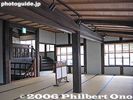
Inside former Ban family residence.
|
|

Neck of Okishima.
|
|
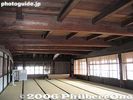
Inside former Ban family residence, 2nd floor.
|
|

Okinoshima Port
|
|
|

Narrow alley
|
|

Former Nishikawa Residence (Kyu-Nishikawa-ke Jutaku), large Omi merchant home designated as an Imnportant Cultural Property. Omi-Hachiman, Shiga. 旧西川家住宅 国重要文化財
|
|

Renmyo was here.
|
|
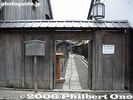
Entrance to Nishikawa Residence. During the Edo Period, the family made their fortune selling mosquito nets and tatami straw matting.
|
|
|
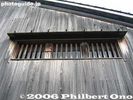
Wall of Nishikawa residence.
|
|
|
|

Inside Nishikawa residence. Omi-Hachiman, Shiga. 国重要文化財畳表や蚊帳を扱っていた江戸時代の豪商・西川利右衛門の旧宅
|
|
|
|
|
|

Hatago inn called Nakamura-ya, this was the only remaining inn in Musa-juku. Unfortunately, this inn was destroyed by an early morning fire on Dec. 10, 2010. No one was hurt. The inn owners were sleeping on the 1st floor and they escaped.
|
|
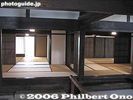
Nishikawa residence.
|
|
|
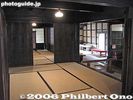
Nishikawa residence.
|
|

Leaving Okinoshima (we'll be back).
|
|
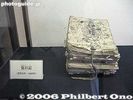
Business diary
|
|
|
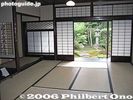
Nishikawa residence.
|
|

Misty Omi-Hachiman coast
|
|

Nishikawa residence.
|
|
|

Nishikawa residence.
|
|
|

Nishikawa residence.
|
|
|
|
|

Hachiman-yama map
|
|

Inn sign. The 200-year-old Nakamura-ya inn burned down on Dec. 10, 2010.
|
|
|
|
|

Musa-juku 武佐宿
|
|
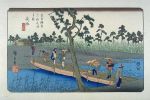
Hiroshige's woodblock print of Musa-juku (67th post town on the Nakasendo) from his Kisokaido series. A bridge of boats.
|
|
|
|
|

Halfway point and rest stop
|
|
|
|

Onegai Jizo-do Hall おねがい地蔵堂
|
|
|
|
|
|
|

The steps never seem to end...
|
|

View from Nishinomaru 西の丸跡
|
|

For people with cars, drive almost to the top
|
|

View from Nishinomaru
|
|

Top in sight
|
|

View from Nishinomaru
|
|

Gate to temple, at lastTook me over 20 min. to climb the 808 steps.
|
|

View of Lake Biwa from Nishinomaru on Mt. Hachimanyama in Omi-Hachiman.
|
|

Water fountain
|
|

Nishinomaru
|
|

Last flight of steps
|
|

Nishinomaru
|
|

Stone lantern sculpture
|
|

Kitanomaru 北の丸跡
|
|

Verse 6 Lyrics (Chomeiji) 六番の英訳(長命寺)Saigoku pilgrimage, Chomeiji.
Dispel this world's impureness, very faraway.
Golden waves on which we weave, rowing all we can.
Tell us my friends your stories, with your fervent hearts.
西国十番 長命寺
汚れの現世 遠く去りて
黄金の波に いざ漕がん
語れ我が友 熱き心
Saigoku Juban, Chomeiji
Kegare no utsushiyo, tooku sarite
Kogane no nami ni, iza kogan
Katare wagatomo, atsuki kokoro
--
This verse is said to refer to the Pure Land of Buddhism. The song has strong Buddhist overtones, but interestingly the melody happens to be based on a Christian hymn. Chomeiji was a lunch stop before they rowed back to Otsu.
See more photos of Chomeiji Temple here.
|
|

"Saigoku pilgrimage, Chomeiji."
|
|

Chomeiji, 31st temple on the Saigoku Pilgrimage Circuit
|
|
|

"Dispel this world's impureness, very faraway."
|
|

3-story pagodaThis is what you first see at the top.
|
|

View from Kitanomaru
|
|

Hondo main hall and pagoda 本堂
|
|

View from Kitanomaru
|
|
|
|

HondoPilgrims often come and chant.
|
|

View from Kitanomaru
|
|

Hondo altar
|
|

View from Kitanomaru
|
|

Hondo altar
|
|

Nishi-no-ko Lake as seen from Kitanomaru atop Mt. Hachiman-yama.
|
|

Hondo altar
|
|

Ema prayer tablet for Chomeiji
|
|

Hondo 本堂
|
|
|

Hondo
|
|

Steps to temple
|
|
|
|
|

Hachiman-yama Castle wall
|
|
|

Site of Hachiman-yama Castle in Omi-Hachiman.
|
|

Roof ornament
|
|

Castle wall
|
|
|

San-mon Gate 山門
|
|

護摩堂
|
|

Zuiryuji Temple of Nichiren Sect in the Honmaru 村雲御所瑞龍寺
|
|
|

Inside temple
|
|

3-story pagoda 三重塔Important Cultural Property
|
|

Lookout in front of temple
|
|
|

View from temple grounds
|
|
|

View of Omi-Hachiman city center from Mt. Hachiman-yama.
|
|
|
|

納礼堂
|
|

Lookout in front of temple
|
|
|
|

Temple grounds
|
|

Inari-do Shrine 稲荷堂
|
|

View of Lake Biwa
|
|
|

Chomeiji is also part of the Lake Biwa Japan Heritage.
|
|

On the way to the main temple is this song monument for Biwako Shuko no Uta (Lake Biwa Rowing Song).
|
|

The Biwako Shuko no Uta song monument is engraved with the song's Verse 6 that mentions Chomeiji.
|
|

With the pagoda in the background, the song monument can be seen on the lower right.
|
|

三仏堂
|
|

Castle wall and fall colors
|
|

三仏堂
|
|
|

三仏堂
|
|
|
|
|

Gift shop
|
|

Bell tower 鐘楼
|
|
|
|

Bell tower
|
|
|
|
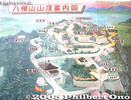
Hachiman-yama map
|
|
|
|

Inside the bell tower. Admission is free, but a small donation is requested to ring the bell.
|
|

You have to go up the steps to ring the temple bell.
|
|

Bell ringer log and rope.
|
|

Temple bell.
|
|

如法行堂
|
|
|
|

As seen from the bell tower
|
|
|

Chomeiji roofs
|
|

大権現社
|
|
|

Giant rock
|
|
|
|
|

天尊堂
|
|

Stairs back down
|
|

Lake Biwa Rowing Song (Biwako Shuko no Uta) monument 琵琶湖就航の歌 歌碑The song is about a four-day, boat-rowing trip around Lake Biwa undertaken on June 27, 1917 by seven college students. They were in the rowing club at an elite college in Kyoto called Dai-san Koto Gakko (No. 3 High School 第三高等学校) which later merged with Kyoto University. They started at Otsu and rowed to Omatsu (now called Omi-Maiko), Imazu, Chikubushima island, Nagahama, Hikone, Chomeiji, and back to Otsu. They stopped overnight at Omatsu, Imazu, and Hikone.
For a detailed explanation of this song and monument, this album.
Biwako Shuko no Uta
|
|

Lake Biwa Rowing Song (Biwako Shuko no Uta) monument 琵琶湖就航の歌 歌碑
|
|

Lake Biwa Rowing Song (Biwako Shuko no Uta) monument for Verse 6 琵琶湖就航の歌 歌碑
|
|
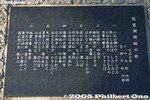
Lake Biwa Rowing Song (Biwako Shuko no Uta) monument 琵琶湖就航の歌 歌碑
|
|

Chomeiji pier
|
|

Chomeiji bus stop
|
|
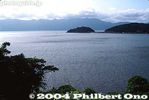
Lakeshore road and Okinoshima island
|
|

Cycling on lakeshore road. There is a scenic cycling path all around Lake Biwa. Takes 2-3 days to cycle around the lake.
|
|

William Merrell Vories is one of the most famous historical figures in Shiga. His legacy remains in physical form in many places through former bank buildings, post office branches, schools, and Christian churches. MAP
|
|

During Oct. 3 to Nov. 3, 2009 in Omi-Hachiman, they held an exhibition of Vories buildings. For 1,000 yen, we were able to enter a few of the buildings normally closed to the public. MAPThe starting point was this Hakuunkan Hall (not Vories-designed).
|
|

Hakuunkan's 1st floor had a registration desk for exhibition visitors. Pay 1,000 yen and you receive tickets to enter a few Vories buildings and a map. The 2nd floor had a panel exhibition introducing Vories.
|
|

Poster for the Exhibition of William Merrell Vories in Omi-Hachiman. The map showed a walking route to see all the Vories buildings.
|
|

A short walk from Hakuunkan was the first Vories building on the map, the former Hachiman Post Office. 旧八幡郵便局舎
|
|
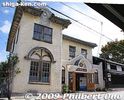
Former Hachiman Post Office in Omi-Hachiman, designed by William Merrell Vories. Built in 1921 and served as a post office until 1960. MAP
|
|

We could also see the 2nd floor which had a panel exhibition of Vories buildings.
|
|

Unfortunately, photography was not allowed inside any of the buildings, which is puzzling since photography is allowed in other Vories buildings open to the public in Shiga.
|
|

The former post office had a crystal glass doorknob on the postmaster office's door.
|
|
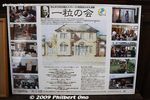
An NPO called Hitotsubu no Kai (一粒の会) has an office inside and they work to renovate the building.
|
|

Next was Shuyukan, a former sake warehouse (not Vories-designed) now serving as an exhibition space and restaurant. The exhibition featured photos of Vories buildings in the summer resort of Karuizawa, Nagano Pref. 酒游舘
|
|
|

The largest Vories building on this tour was the Hyde Memorial Building at this school called the Omi Kyodaisha Gakuen (Omi Brotherhood Schools). 近江兄弟社学園ハイド記念館(旧淸友園幼稚園).
|
|

On the right is the Hyde Memorial Building designed by William Merrell Vories. 近江兄弟社学園ハイド記念館(旧淸友園幼稚園)
|
|

The Hyde Memorial Building was built in 1931 to serve as Seiyuen Kindergarten run by Hitotsuyanagi Makiko, Vories' wife from 1919. MAP
|
|

Statue of Vories.
|
|

The construction of the kindergarten building was financed by the wife of Albert Alexander Hyde, the founder of The Mentholatum Company. This building was thus named after Hyde.
|
|

Vories acquired the rights to sell Mentholatum products in 1920, and his Omi Sales Company sold the product in Japan as, "Menturm." It was a good source of income to finance his activities.
|
|

Hyde Memorial Building.
|
|

Other side and entrance to the Hyde Memorail Building. Inside were panel exhibitions related to Vories' medical and educational activities.
|
|
|

Entrance to Hyde Memorail Building.
|
|

Education Building called Kyoiku Kaikan. 教育会館
|
|

Kyoiku-kan is attached to the Hyde Building. 教育会館
|
|

Omi Kyodaisha Gakuen is also one location where the film Idai Naru, Shurararabon (偉大なる、しゅららぼん The Great Shu Ra Ra Boom) was filmed.
|
|

Display of posters of past Vories exhibitions.
|
|

We were also allowed to see the chapel in the school's main building here. The chapel was on the 5th floor. This building was completed in March 2007. 学園本館
|
|

Vories Memorial Chapel on the 5th floor of the Omi Brotherhood Schools main building. ヴォーリズ平和礼拝堂
|
|

Near the school is this residence where Vories and his wife Makiko lived during the latter half of their lives. The house is normally not open to the public. Sometimes you can see inside the house if you make an appointment. ヴォーリズ記念館
|
|

Although this was Vories' residence, he did not own the house. He did not believe in having private assets. We could see the large living room full of pictures, books, etc., and the Japanese-style room for Makiko. ヴォーリズ記念館(旧ヴォ
|
|

Name plate at the front gate of the Vories residence, called the Hitotsuyanagi Memorial House. It is designated as a Tangible Cultural Property of Shiga. MAP
|
|
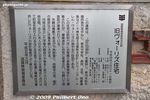
About the former Vories residence. It is owned by the Omi Brotherhood Co. The house was originally built in 1931 as a dormitory for teachers at the kindergarten, but it was turned into a residence instead. A Japanese-style room was also added.
|
|
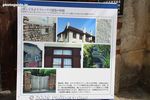
The Vories residence has three chimneys. Web site: http://vories.com/
|
|
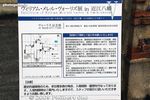
Map of the tour route.
|
|
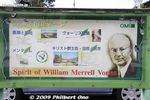
The Omi Brotherhood Corporate Group is involved in education, medicine and welfare, architectural design, and health-care products.
|
|
|

Matsuoka Residence. 村岡邸
|
|
|
|